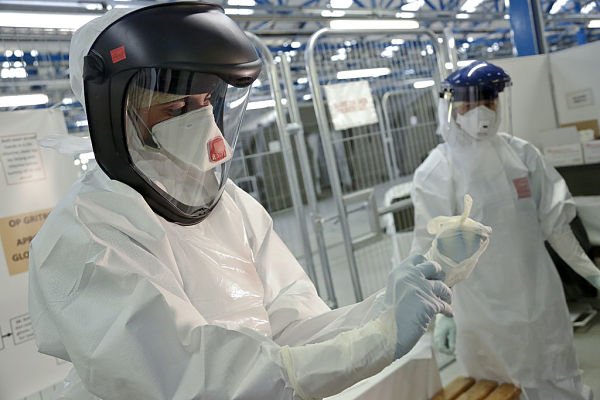 Impact
Impact Scared Straight: Evidence Makes for Better Biosecurity Rules

This is nothing – what really scares me is the paperwork afterwards! (Photo: British army trainers instruct NHS personnel how to dress to deal with Ebola. Credit: Simon Davis/DFID)
[Ed. – This is an installment in an occasional series looking at the impact of social and behavioral science research on policy and wider society.]
Here’s a simple question: which is scarier, a) mucking around with deadly pathogens in the lab, or b) filling out the paperwork about mucking around with those pathogens? In the wake of 9/11, and the anthrax scare that followed those terrorist attacks, the answer in most U.S. laboratories was ‘b.’That was the counter-intuitive takeaway from research that lawyer and scientist Victoria Sutton had been doing into risk perception in the biosecurity field, and her findings actually resulted in an executive order the next year to make ‘a’ the answer. Even more unusually, the executive order specifically cited Sutton’s work – “one telling study” — as evidence for the rules change.
“Interestingly,” wrote Peter Emanuel, the then-assistant director for chemical and biological countermeasures at the White House’s Office of Science and Technology Policy (OSTP), in a 2010 blog post announcing the order, “while only 16% of the 198 surveyed scientists reported being moderately or highly stressed about the possibility of injury or death from their work with some of the world’s deadliest pathogens, nearly two-thirds of them said they were moderately to highly stressed about the possibility they might unwittingly break a rule!”
 Her two-page paper in Biosecurity and Bioterrorism: Biodefense Strategy, Practice, and Science had already been cited in two National Academies and one American Association for the Advancement of Science reports in 2009, but it picked up even more momentum after the Obama administration’s shout-out, with her paper being one of two spotlighted in a Nature news article titled “Regulations increase cost of dangerous-pathogen research.”
Her two-page paper in Biosecurity and Bioterrorism: Biodefense Strategy, Practice, and Science had already been cited in two National Academies and one American Association for the Advancement of Science reports in 2009, but it picked up even more momentum after the Obama administration’s shout-out, with her paper being one of two spotlighted in a Nature news article titled “Regulations increase cost of dangerous-pathogen research.”
Sutton, a law professor at the Texas Tech University School of Law and director of the Center for Biodefense, Law and Public Policy at Texas Tech, found the incident sweet vindication of her long-time focus on evidence-based policy making, especially evidence drawn from social and behavioral research. “Relying on social sciences data to make policy decisions is the kind of situation that is really a win-win-win for everyone — the government policymaker who has made an evidence-based policy; the public both for better policy and a return on their taxes for investment in research; and the researcher.” That this example involved an issue of critical national security with huge repercussions for the public’s welfare just made the victory sweeter.
Sutton’s journal being at the nexus of law, science and policy in the biosecurity field has crossed many disciplinary boundaries and earned her a Ph.D. in environmental sciences, a masters of public administration and a law degree from American University’s Washington College of Law. She also served in several science-oriented roles during the administration of the first President Bush, including time as an assistant director at OSTP. She’s now the chair elect of the law and social sciences committee at American Association of Law Schools. Although she can address a number of disparate issues, ranging from trademark protection for sports mascots to scary law cases for Halloween, her specialty at Texas Tech is biosecurity regulation and law, “a broad area that really came out of need to enhance national security.”
Despite being a senior academic, her research on biosecurity regulations first gained prominence at the poster session of a biodefense-oriented conference, literally putting up her own work alongside her own law students’ posters. “I think if you want to cross disciplines and do interdisciplinary work and show people in that discipline how you apply your methods or that you are researching something that will influence their career, you have to change your perspective on the narrative for traditional academic behavior,” she said. “I think the poster session is where some of these unique, cutting-edge ideas can emerge.”
Her poster followed up from a survey she had conducted among researchers working with bacteria and viruses. “There was a concern across the country,” she explained, “that biodefense researchers were worried so much about inadvertently violating the regulations that their not really able to focus on the things the policy intended for them to focus on about being safe and doing their work.” Their bureaucratic worries so trumped the more obvious concerns about the pathogens and toxins they worked with that Sutton flatly declared that the biosecurity regulations (the Select Agent Program), “after its first 5 years, has flaws that may thwart it from achieving its statutory goals.”
She reported those finding back to her survey participants, and strove to publish in journals where people read about information like this, focusing less on impact factors and more on impact.
A few people at the National Institutes of Health, which funded the original work, started asking her around, and the biosecurity section in White House asked for private briefings with four or five people. “I had opportunity to do a lot of small briefings,” Sutton recalled. “Then nothing happened. When you do this sort of research, you don’t really expect big things, you just hope your part of the incremental movement for change. And 99 times out of a hundred nobody remembers your name, but they remember your research.”
Her success in breaking through, she feels, was helped by working on a hot topic – national security is usually a selling point – and her determination to sound the same themes until she was certain she’d been heard. “The regulated community also had a lot to do with it [surfacing],” Sutton said. “I quantified what people felt in the community, but nobody was willing to take action until it was actually quantified – and qualified – in the survey.”
***
See Vickie Sutton describe her work in one minute!




















































































